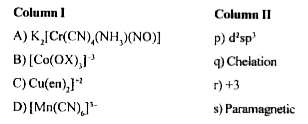Statement-1 : [Ni(CO)4] has square planar geometry while [Ni(CN)4]4−has tetrahedral geometry.
Statement-2 : Geometry of above complexes depends upon the nature of ligands attached. Solution in Malayalam
Statement 1 is True, Statement 2 is True, Statement 2 is Correct explanation for Statement 1.
Statement 1 is True, Statement 2 is True, Statement 2 is NOT a correct explanation for Statement 1.
Statement 1 is True, Statement 2 is False.
Statement 1 is False, Statement 2 is True.
The correct Answer is:D
Ni(CO)4 has tettrahedral geometry and [Ni(CN)4]4− has square planar geometry. [Ni(CO)4] possesses sp3 hybridization whereas [Ni(CN)4]4− has dsp2 hybridization to show square planar geometry.
Topper's Solved these Questions
- COORDINATION COMPOUNDS BOOK - BRILLIANT PUBLICATIONCHAPTER - COORDINATION COMPOUNDS EXERCISE - LEVEL III (Linked Comprehension Type) (Paragraph- I)
3 Videos
- COORDINATION COMPOUNDS BOOK - BRILLIANT PUBLICATIONCHAPTER - COORDINATION COMPOUNDS EXERCISE - LEVEL III (Linked Comprehension Type)(Paragraph II)
4 Videos
- COORDINATION COMPOUNDS BOOK - BRILLIANT PUBLICATIONCHAPTER - COORDINATION COMPOUNDS EXERCISE - LEVEL III (Matching Column Type)
4 Videos
- CO-ORDINATION COMPOUNDS AND ORGANOMETALLICSBOOK - BRILLIANT PUBLICATIONCHAPTER - CO-ORDINATION COMPOUNDS AND ORGANOMETALLICSEXERCISE - Level-II (Assertion- Reason)
4 Videos
- D & F BLOCK ELEMENTSBOOK - BRILLIANT PUBLICATIONCHAPTER - D & F BLOCK ELEMENTSEXERCISE - Level -II
38 Videos
Similar Questions
Which is correct in the case of [Fe(CN)6]4− complex ?
View SolutionWhen degenerate d-orbitals of an isolated atom/ion come under influence of magnetic field of ligands, the degeneracy is lost. The two sets t2g(dxy,dyz,dxz)andeg(dx2,dx2−y2) are either stabilised or destabilised depending upon the nature of magnetic field. It can be expressed diagramatically as:
Value of CFSE depends upon nature of ligand and a spectro-chemical series has been made experimentally, for tetrahedral complexes Δt is about 4/9 times to Δ0 (CFSE for octahedral complexes).

This energy lies in visible region and ie, why electronic transition t2g⇔eg are responsible for colour. Such transitions are not possible d0andd10 configuration.
Cr3+ form four complexes with four different ligands which are [Cr(Cl)6]3−,[Cr(H2O)6]3+,[Cr(NH3)6]3+and[Cr(CN)6]3−. The order of CFSE (Δ0) in these complexes is :

View Solution
View SolutionAssertion : The complex ion [Ni(en)3]2+ has lesser stability than [Ni(NH3)6]2+
Reason : ln[Ni(en)3]2+, the geometry is square bipyramidal
View SolutionWhich of the following is not the characteristion of transition metal ?
View SolutionThe geometry and magnetic behaviour of the complex [Ni(CO)_4] are
View SolutionThe complex [NiCl4]2− has tetrahedral geometry while [Ni(CN)4]2− has square planar geometry. Explain.
View SolutionAccount for the fact that [Ni(CO)4] has tetrahedral geometry whereas [Ni(CN)4]2− has square planar geometry.
View SolutionThe geometry of [Ni(CN)_4]^(2-) is
View SolutionThe geometry of[Ni(CN)4]2− is
View SolutionThe geometry of[Ni(CN)4]2− is
View SolutionThe geometry of[Ni(CN)4]2− is
View SolutionThe geometry and magnetic behavior of the complex [Ni(CO)4] are
View Solution[Ni(CO)4]द्वारा ज्यामिति प्राप्त होती है
View SolutionThe geometry of. Ni(CO)4 and Ni(PPH3)2CI2 are :
View SolutionThe geometry of Ni(CO)4 and Ni(PPh3)2CI2 are :
View Solution
